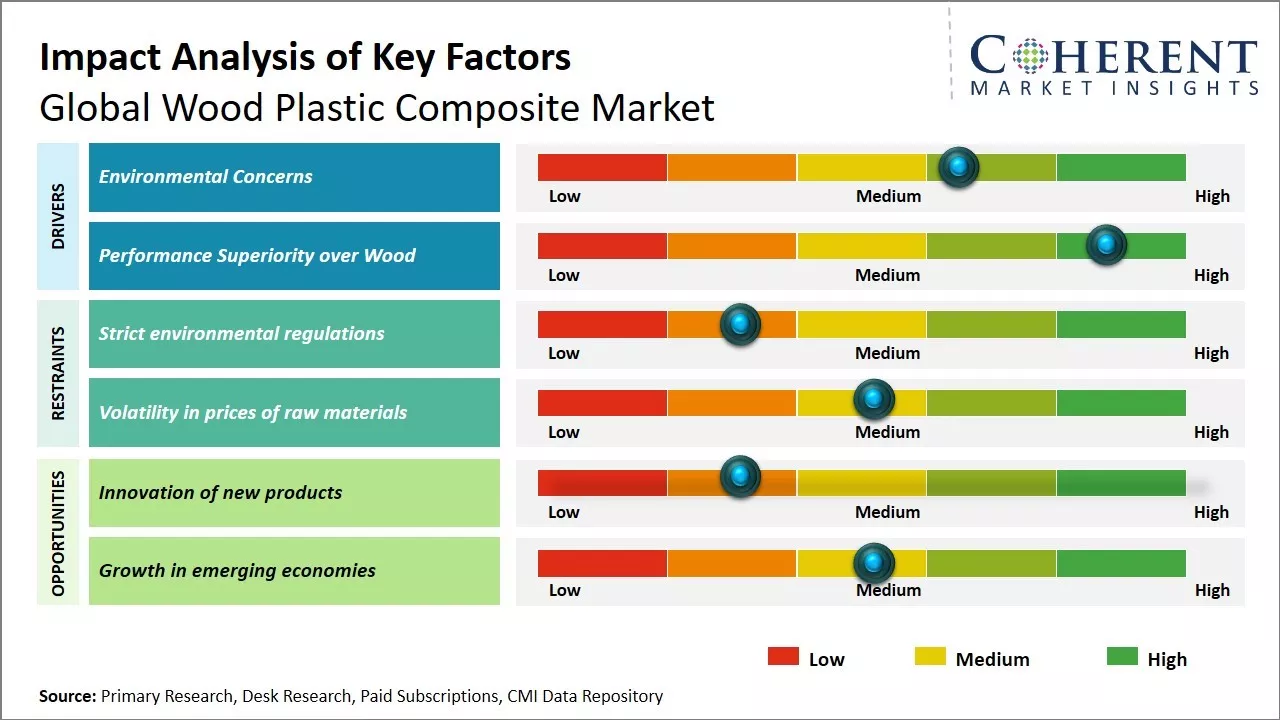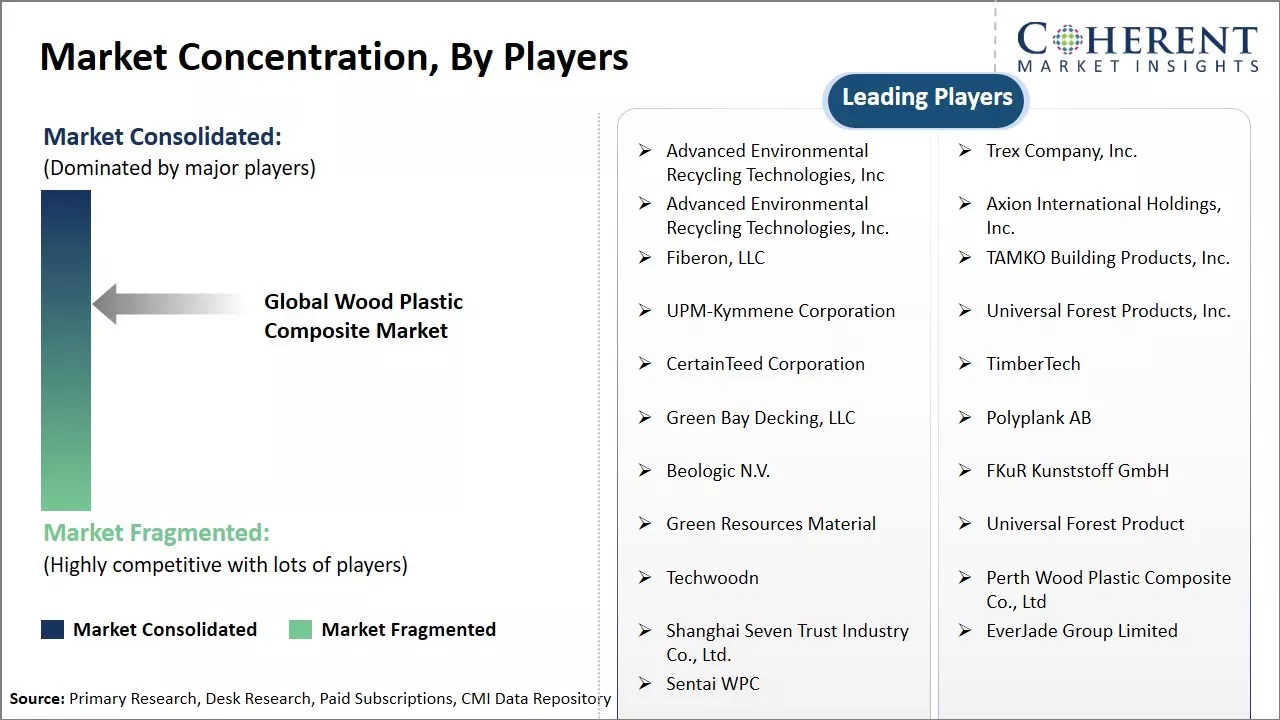The global wood plastic composite market is estimated to be valued at USD 9.06 Bn in 2025 and is expected to reach USD 17.68 Bn by 2032, growing at a compound annual growth rate (CAGR) of 10.0% from 2025 to 2032.

To learn more about this report, Download Free Sample
Wood plastic composites (WPC) industry is anticipated to record strong growth over the forecast period, spurred by growing demand for low-maintenance, durable, and sustainable products in construction, automotive, and consumer goods markets. WPCs, which are composite materials composed of wood fibers or flour and thermoplastics, possess high strength, durability against water and rot, and visual design freedom, thereby being highly suitable for decking, fencing, exterior cladding, and interior finishes. Increased environmental awareness, government policies supportive of green building materials, and advancements in extrusion and injection molding technologies are driving the market in both developed and emerging economies.
In April 2024, Trex Company Inc., a top U.S.-based wood-alternative decking products manufacturer, introduced its new "Trex Transcend Lineage" series. The next-generation WPC product line comes with more advanced heat-mitigating technology and ultra-fade-resistant color, positioned in the premium outdoor living space and further solidifying Trex's leadership in green construction materials.
|
Current Events |
Description and its impact |
|
Sustainability Drive Spurs Innovation in Wood Plastic Composites (WPC)
|
|
|
Automotive Industry Adoption of WPCs Grows Amid Lightweighting Trends
|
|
Uncover macros and micros vetted on 75+ parameters: Get instant access to report
Emerging technologies are critically influencing the development, quality, and sustainability of the Wood Plastic Composites (WPC) industry. Technical advances in materials science, processing methods, and product engineering are making it possible to produce composites with superior performance that satisfy demanding durability, environmental, and aesthetic requirements.
One of the most important developments is in co-extrusion technology that enables manufacturers to produce multi-layered WPC products with enhanced surface properties like better UV resistance, colour retention, and moisture barrier performance. This has enabled the development of capped WPC decking and cladding that performs better than conventional materials in terms of durability and appearance.
Additive technology has also come a long way to enable the addition of antimicrobial agents, flame retardants, and impact modifiers to make WPCs suitable for specific end-user applications like outdoor furniture, marine decking, and industrial flooring. The use of recycled polymers and agro-residues is also picking up pace, fueled by circular economy and tighter green legislation. This not only reduces the carbon footprint of manufacturing but also cuts raw material costs.
Automation and AI-based quality control systems in manufacturing plants are also enhancing consistency, minimizing waste, and maximizing production efficiency. In addition, 3D printing and digital modeling

To learn more about this report, Download Free Sample
Rising environmental concerns across the globe are significantly driving the growth of the global wood plastic composite market. More and more people are becoming aware of the need to reduce the use of plastics coming from petrochemicals that are not biodegradable and have a very high carbon footprint. At the same time, the disposal and recycling of plastic products is becoming a huge problem.
Plastics clogging landfills and oceans are causing severe ecological damage. Wood plastic composites provide a solution to these issues as they combine two naturally sourced materials - wood and bio derived plastics. When compared to normal plastics, WPCs have significantly lower carbon footprint and are partially biodegradable. Some WPC products can completely decompose when the polymers used are compostable. This environmental advantage of wood plastic composites is appealing to both businesses and consumers who want to switch to more sustainable alternatives.
Various governments are also promoting the use of eco-friendly construction materials through regulatory pushes and subsidies. With sustainability becoming a key business priority, more brand owners want to increase the use of WPCs in their product portfolio.
While wood looks aesthetically beautiful, it has weaknesses like sensitivity to moisture, fragility, and propensity to warp or crack easily. On the other hand, the integration of plastics into wood through various compounding technologies significantly enhances the engineering properties of the final composite. WPCs are stronger, harder, and lighter in weight and have excellent dimensional stability. They can withstand cracking, splitting, and rotting and termite attacks much better than normal wood.
The resins and polymers blended with wood fibers provides protection from moisture ingress and makes composites impervious to various environmental factors. These performance upgrades make WPC suitable for a variety of applications that requires durability and longevity. Whether in the form of decking, railing, fence, window, or door; wood plastic composites can last considerably longer without requiring frequent repairs and replacement.
In April 2025, Trex Company, Inc., the world's largest manufacturer of wood-alternative decking and railing products, was honored with the Product of the Year and Judges’ Choice awards in the Consumer + Residential category at the Environment + Energy Leader Awards.
Strict environmental regulations around the use of plastic are making WPC production more expensive. Furthermore, the unstable prices and supply of plastic polymers add volatility to WPC manufacturing costs. Customer preferences are also shifting towards more sustainable materials than WPCs. These composites also have issues with moisture absorption, cracking, and poor longevity when used outdoors.
Development of advanced wood plastic composite materials that are stronger, longer lasting, and more durable than traditional materials allow manufacturers to access new applications and customer segments. These hybrid materials combine the beneficial properties of both plastics and lumber, resulting in products that are resistant to moisture damage while also being lighter weight.
As environmental sustainability becomes an increasingly important consideration, demand is rising for composite materials that reduce reliance on depleting wood sources. Composites allow for wood waste recycling and utilize a significantly smaller amount of virgin wood fibers compared to solid wood alternatives. They also prolong the life of wood resources
The PP-based composites segment is expected to contribute 36.0% of the market share in 2025 in the global wood plastic composite market owing to its excellent properties. PP provides superior resistance to moisture when compared to other materials like PE and PVC. This makes it an ideal choice for applications that require moisture resistance like outdoor decking and railings.
PP composites also demonstrate high thermal stability and can withstand temperature variations without significant impact on its strength and appearance. This gives it an edge over other materials in applications involving heat exposure. PP also imparts a smooth and aesthetic look to composites. This makes PP-based wood plastic composites a popular choice for applications requiring an elegant finish like indoor and outdoor furniture.
The polymer is lightweight and provides impact and weather resistance to the composite materials. PP composites do not rot, splinter, or corrode ensuring long lifespan of the final product. Being non-toxic and odorless, PP composites are safer and more environment-friendly than other choices like PVC.
The building and construction segment is expected to hold 38.3% share in 2025 in the global wood plastic composite market due to increasing emphasis on sustainability in the industry. Wood plastic composites provide an eco-friendly alternative to conventional building materials like wood, plastic, and concrete.
They require lesser energy to produce and help reduce greenhouse gas emissions over their lifecycle in comparison. WPCs do not deteriorate from effects of moisture, rot, insects, or ultraviolet light ensuring longer service life of structures. This translates to reduced maintenance and disposal costs.
Additionally, economical wood plastic profiles are widely used as an alternative to popular decking, railing and fencing materials. They can be sawn, routed, drilled, and easily installed like wood. However, their non-biodegradable nature means no replacement is needed for decades.
Growing consumer preference for sustainable green buildings along with policy support is driving greater adoption of wood plastic composites in new constructions as well as renovations. Rapid urbanization worldwide has significantly boosted demand from the construction segment.

To learn more about this report, Download Free Sample
North America has been dominating the global wood plastic composite market owing to a strong presence of key manufacturers in the region in 38.1% share in 2025. Countries like the U.S. and Canada have a robust wood plastic composite industry that caters to the growing demand from the construction as well as automotive sectors. Majority of the wood plastic composite production facilities are located in North America which ensures easy availability of products.
Additionally, a strong manufacturing base helps North American manufacturers to benefit from economies of scale and thereby offer products at competitive prices. The regulations also support the usage of innovative materials like wood plastic composites for infrastructure development in the region.
The Asia Pacific region has emerged as the fastest growing market for wood plastic composites globally. Rapid urbanization and investment in infrastructure development across countries like China, India, Indonesia, Vietnam, and Malaysia is driving the demand. The construction industry in the Asia Pacific region focuses on sustainable construction practices and wood plastic composites are widely accepted as environment-friendly alternative to wood and plastics.
Countries in the region also have an abundant availability of wood and polymers which are key raw materials for wood plastic composite manufacturing. Further, the presence of emerging economies provides the advantage of low production costs. This has attracted several North American and European manufacturers to set up production plants in Asia Pacific through joint ventures or inbound mergers and acquisitions.
The U.S. is a major market for WPCs, led mainly by the construction and decking markets. Strong consumer recognition of sustainable materials, robust DIY culture, and friendly building codes have sustained steady demand. Leading players such as Trex and Advanced Environmental Recycling Technologies (AERT) dominate product innovation and market share.
China is also the leading producer and consumer of WPCs. Sustained urbanization, infrastructure growth, and government encouragement of the use of green building materials have driven the market. The sheer size of its manufacturing capacity allows for economical production to make it the world's largest exporter of WPCs for use in furniture, interiors, and outdoor products.
Germany dominates the WPC market in Europe, supported by a strong emphasis on circular economy practices and strict environmental regulations. Germany's automotive and construction industries are adopting WPCs in order to achieve sustainability goals, with research leading to enhanced performance and recyclability of composites.
| Report Coverage | Details | ||
|---|---|---|---|
| Base Year: | 2024 | Market Size in 2025: | USD 9.06 Bn |
| Historical Data for: | 2020 To 2024 | Forecast Period: | 2025 To 2032 |
| Forecast Period 2025 to 2032 CAGR: | 10.0% | 2032 Value Projection: | USD 17.68 Bn |
| Geographies covered: |
|
||
| Segments covered: |
|
||
| Companies covered: |
Advanced Environmental Recycling Technologies. Inc , Trex Company. Inc. , Advanced Environmental Recycling Technologies, Inc. , Axion International Holdings, Inc., Fiberon, LLC , TAMKO Building Products, Inc. , UPM-Kymmene Corporation , Universal Forest Products, Inc. , CertainTeed Corporation, TimberTech , Green Bay Decking, LLC, Polyplank AB , Beologic N.V. , FKuR Kunststoff GmbH , Green Resources Material, Universal Forest Product, Techwoodn , Perth Wood Plastic Composite Co., Ltd, Shanghai Seven Trust Industry Co., Ltd. , EverJade Group Limited , and Sentai WPC |
||
| Growth Drivers: |
|
||
| Restraints & Challenges: |
|
||
Uncover macros and micros vetted on 75+ parameters: Get instant access to report
Share
Share
About Author
Vidyesh Swar is a seasoned Consultant with a diverse background in market research and business consulting. With over 6 years of experience, Vidyesh has established a strong reputation for his proficiency in market estimations, supplier landscape analysis, and market share assessments for tailored research solution. Using his deep industry knowledge and analytical skills, he provides valuable insights and strategic recommendations, enabling clients to make informed decisions and navigate complex business landscapes.
Missing comfort of reading report in your local language? Find your preferred language :
Transform your Strategy with Exclusive Trending Reports :
Frequently Asked Questions
Joining thousands of companies around the world committed to making the Excellent Business Solutions.
View All Our Clients